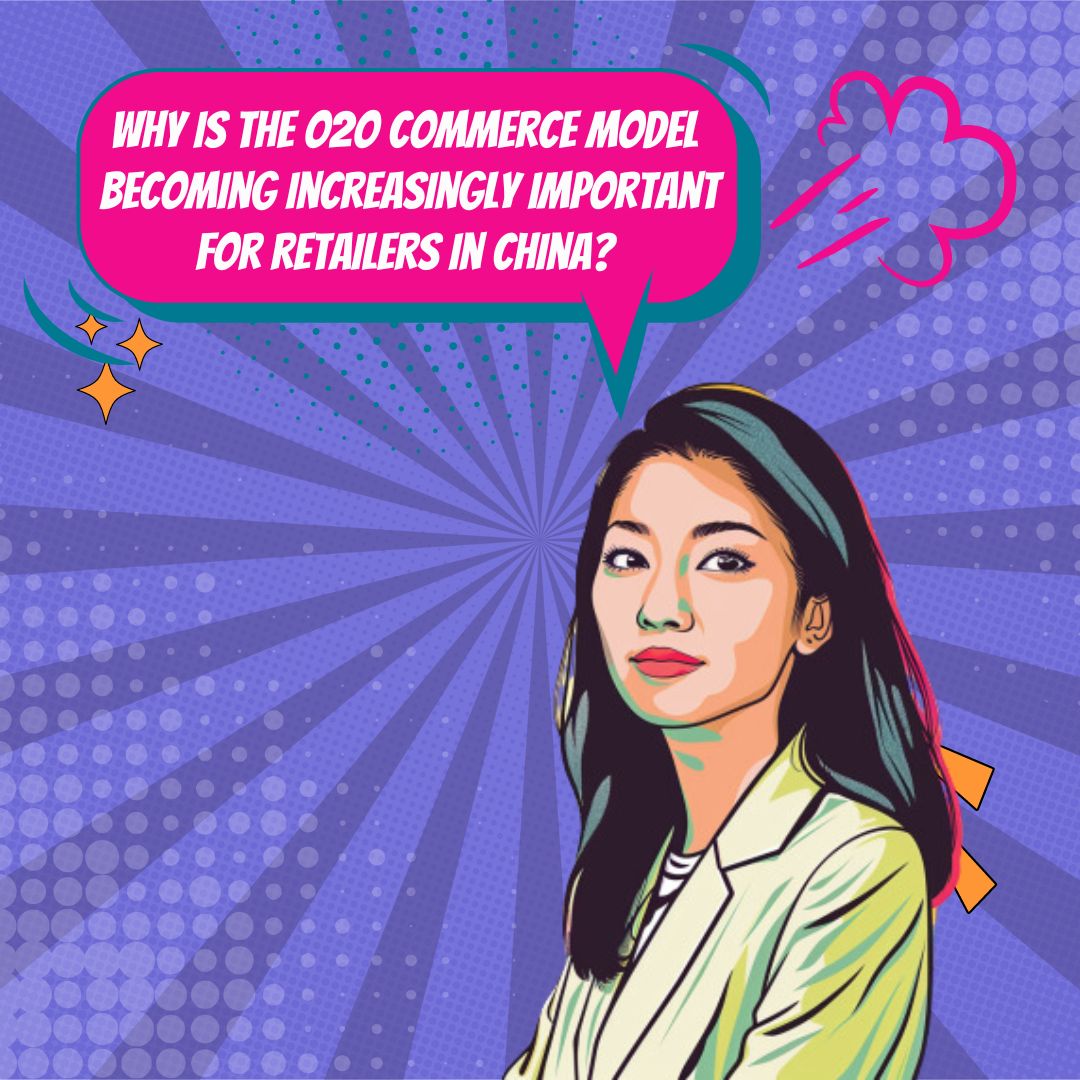Key Takeaways
✅ Seamless Integration: Customers in China enjoy shopping without friction, where O2O Commerce blurs the lines between digital browsing and the tactile in-store experience. Statistics reveal that shoppers who engage with both online and offline channels tend to spend up to four times more than those who don't, signaling the significant revenue potential of a well-integrated O2O approach.
✅ Mobile Payment Dominance: Mobile payments aren't just an add-on in China; they're essential, with over 50% of transactions completed via mobile devices. The success of O2O Commerce often hinges on embracing platforms like Alipay and WeChat Pay, central to this retail revolution.
✅ Personalization and Data Analytics: Data isn't just a buzzword—it's the backbone of O2O Commerce personalization. Retailers who leverage customer insights can achieve up to a 25% increase in sales by fostering targeted engagement and custom-tailored shopping experiences that resonate with individual consumer needs.

Introduction
Ever wondered why shopping isn't what it used to be? The retail game has changed, especially in China, where O2O Commerce isn't merely thriving; it's redefining 'shopping' for a billion-strong market. Curious about how this change is fueling a retail renaissance and possibly reshaping global commerce?
Join us as we slice through the digital buzz and get to the core of what makes online-to-offline retail tick. From convenience and personalized shopping to Alibaba's New Retail vision, we've got the latest on maximizing sales and staying competitive. Imagine tapping into a world where every customer interaction is an opportunity, where O2O Commerce strategies turn shopping into a seamless, immersive journey—an intersection of digital intelligence and physical allure.
Ready to unlock actionable insights and groundbreaking information? We've outlined the game-changers and trendsetters in China's retail landscape, providing you with the tools and knowledge to ride the wave of O2O and amplify your reach. Let's dive into this transformative space—that's shaping not just China, but potentially, the future of retail worldwide.
Top Statistics
| Statistic | Insight |
|---|---|
| Market Size and Growth: China's O2O market reached 1.67 trillion yuan ($257.3 billion) in 2020, with a 12.1% increase from the previous year. (Source: iResearch) | This impressive growth highlights the burgeoning market opportunity and the consumer appetite for integrated shopping experiences. |
| User Demographics: A staggering 91.6% of Chinese consumers aged 18-60 participated in O2O shopping in 2020. (Source: iResearch) | Participation rates of this magnitude suggest a mainstream adoption and comfort level with O2O services across nearly all adult age groups in China. |
| Payment Methods: Mobile payment took the lead for O2O transactions in China, accounting for 72.6% of the market in 2020. (Source: iResearch) | The dominance of mobile payment is an essential consideration for businesses, indicating that a seamless mobile payment experience is key to capturing market share. |
| Popular O2O Services: Food delivery services reigned supreme, grabbing a 39.2% slice of the O2O market in 2020. (Source: iResearch) | This statistic reveals consumers' heavy reliance on digital platforms for routine tasks, suggesting that services addressing everyday needs drive consumer engagement. |
| Industry Forecasts: The integration of AI is expected to be a major growth driver for the O2O market in China. (Source: Deloitte) | Businesses should gear up for the technological advancements AI brings, potentially revolutionizing personalization and efficiency in O2O commerce. |
Understanding O2O Commerce
O2O commerce, or Online-to-Offline commerce, is a business model that ties the convenience of online shopping with the tangibility of offline stores. Think of it as a bridge that connects the digital and physical shopping worlds. In China, one of the most striking examples of this concept is Alibaba's "New Retail" initiative, which is quickly becoming a standard for retailers nationwide. This development has transformed China's retail landscape, fostering an environment where consumers shop through an app, pay with their phones, and either receive their goods at home or pick them up at a physical store.
Benefits of O2O Commerce for Consumers
One of the standout aspects of O2O is the convenience and accessibility it offers. Consumers can browse products online, make decisions, and have their goods delivered or ready for collection almost immediately. This model also allows for personalized shopping experiences through data analytics, offering recommendations and deals tailored to individual preferences. Enhanced customer engagement is another benefit, as brands can interact with consumers through both digital platforms and physical touchpoints, leading to stronger brand loyalty.
Key Players in China's O2O Commerce Market
Several giants dominate the O2O commerce scene in China. Alibaba, with its extensive ecosystem including Taobao, Tmall, and Alipay, is a powerhouse in integrating online and offline retail. JD.com boasts a robust omnichannel strategy that leverages advanced logistics to expedite deliveries. On the other hand, Meituan is reinventing food delivery and bricks-and-mortar services, while Pinduoduo emphasizes a social commerce approach, encouraging group buying and social interactions.

Innovative O2O Commerce Strategies in China
China is not just following trends; it's setting them through New Retail. Furthermore, the surge of livestreaming commerce has revolutionized the way products are showcased and sold. Incorporating AR/VR-powered shopping experiences has made online shopping tactile and interactive, enhancing consumer engagement. Lastly, weaving social media and e-commerce has turned shopping into a communal event.
Challenges and Opportunities in China's O2O Commerce Landscape
While O2O commerce is opening doors, there are hurdles to overcome. Developing a logistics and delivery infrastructure that can keep pace with demand is challenging. Moreover, addressing data privacy and security concerns is paramount in gaining consumer trust. However, immense opportunities exist for small businesses and startups to innovate within this space, and the advent of 5G technology could vastly improve O2O experiences with faster and more reliable connections.
The Future of O2O Commerce in China
Looking ahead, O2O in China is likely to continue evolving at a rapid pace, with continuous innovation and adaptation being a necessity for businesses to stay competitive. There's also great potential for Chinese O2O commerce leaders to expand globally, influencing how the rest of the world approaches retail in the digital age. The future will likely see an even more seamless integration between online and offline channels, making shopping an ever more convenient and personalized experience.

By providing clear insights and leveraging current data and statistics, this analysis paints a picture of O2O commerce that's comprehensive yet approachable for those new to the concept while still offering depth for the informed reader. With the central theme of integration, O2O commerce in China stands as a compelling testament to how technology can reinvent traditional industries and consumer habits.
AI Marketing Engineers Recommendation
Recommendation 1: Leverage Localized Data Analytics for Personalized Experiences: Harness O2O Commerce by utilizing detailed customer data gathered from both online behaviors and offline shopping habits. A study by McKinsey on China's digital consumers revealed they expect personalized and tailored experiences. Apply machine learning algorithms to this data to create unique user profiles, which can then drive personalized marketing messages, product recommendations, and even tailored in-store experiences. For example, an e-commerce app could notify a customer about a product they were browsing online when they enter the physical store. This seamless transition between online and offline can increase conversion rates by up to 30%, as reported by a joint study between Google and Ipsos.
Recommendation 2: Optimize Omnichannel Customer Service Journeys: With 87% of retail sales in China expected to be influenced by digital according to a Boston Consulting Group report, it is essential to offer a flawless integration between online information and offline services. Create consistency across all customer touchpoints, such as equipping store representatives with handheld devices to provide real-time inventory checks or allow online reservations for in-store pickups. Invest in training for frontline staff to ensure they are knowledgeable about online promotions and services, effectively merging the online-offline experience and improving customer satisfaction.
Recommendation 3: Implement AR and VR Technologies to Enhance Shopping Experience: Integrating O2O commerce isn't just about data and customer service; it's about creating engaging shopping environments too. Incorporating augmented reality (AR) and virtual reality (VR) into both online and offline channels can provide immersive experiences that bridge the gap between the two worlds. For instance, Alibaba's "New Retail" technology uses AR for customers to try on clothes virtually at home or navigate stores interactively. Meanwhile, VR shopping events can lead to online sales or drive traffic to brick-and-mortar locations for an enhanced physical experience. Reports show that these technologies can boost customer engagement significantly – as much as by 66%, according to the International Journal of Advanced Studies in Computers, Science, and Engineering.
Relevant Links
- Harness the Power of Online-to-Offline (O2O) Commerce
- Unlock the Secrets to ROI Driven Marketing with AI
- Top AI Tools That Are Revolutionizing Customer Service
- AI Innovations That Can Transform Your Business Operations
- Crafting Creative Content with Generative AI
Conclusion
As we reflect on the merging world of O2O commerce, it's crystal clear that China is not just leading the way, but it's also redefining the retail experience altogether. From the bustling streets of Shanghai to the digital corners of the internet, the line between online shopping and brick-and-mortar stores has blurred, painting a new picture of consumer convenience and engagement. The power players—Alibaba, JD.com, Meituan, and Pinduoduo—have transformed shopping into a personalized, seamless activity pinned with endless possibilities.
These titans have opened up a realm where augmented reality (AR) and virtual reality (VR) are no longer futuristic concepts but tools that enhance the shopping experience today. Strategies, like Alibaba's New Retail, have set a precedent that's rippling across the globe, influencing others to follow suit. Live streaming, once a mere entertainment channel, is now a robust sales machine, proving why China's O2O approach is not just a local phenomenon but a global trendsetter.
However, breakthroughs do come hand-in-hand with hurdles. Addressing challenges such as logistics optimization, safeguarding customer data, and overcoming the digital divide are just as crucial to the growth and sustainability of O2O commerce. Meanwhile, 5G technology emerges as a beacon of hope, promising to further streamline these integrated experiences, creating opportunities for not just conglomerates, but also small businesses and startups looking to carve out their niche in this expansive marketplace.
Looking ahead, the future of O2O commerce in China is poised for even greater heights—and it's not slowing down. Aren't we all curious about where this synergy between online and offline shopping will take us? Will it redefine convenience as we know it? One thing is certain: with continuous innovation and adaptation, China's O2O commerce is reshaping retail not just within its borders but also setting a new standard for the world to follow. So, when we talk about the shopping experience of tomorrow, it's evident that we'll be looking East for inspiration. And who knows, perhaps what we imagine as the shopping world of the future is already happening today in China.

FAQs
Question 1: What is O2O Commerce?
Answer: O2O Commerce is the savvy blend of the digital world and the hands-on experience of a physical store. It's where clicks meet bricks, allowing businesses to channel the power of the internet to get folks stepping through the door of a real, tangible shop.
Question 2: Why is O2O Commerce important in China?
Answer: In a land as vast and digitally connected as China, the crunch of online crowd's footsteps heading into stores is music to a retailer's ears. It's a game of connecting dots from online browsing to offline buying, and with giants like Alibaba on the playground, it's a serious business boon!
Question 3: What are the key components of O2O Commerce in China?
Answer: Imagine a Swiss Army knife; now imagine it's for shopping. That's your O2O Commerce. It's mobile wallets, social buzz, your phone knowing you're near a store, those special offers that seem just for you, and a shopping journey as smooth as silk.
Question 4: How do mobile payments fit into O2O Commerce?
Answer: Mobile payments are like the glue in O2O Commerce—they hold everything together. With a tap here and a click there, Alipay and WeChat Pay stitch the online to the offline, making buying a breeze, whether you're on your couch or in the store.
Question 5: What role does social media play in O2O Commerce?
Answer: Think of social media as the town crier of O2O Commerce. It's shouting out the latest deals, showing off shiny products and funneling folks into shops. It's the digital chatbox that's bringing the browsing and the buying together.
Question 6: How can location-based services enhance O2O Commerce?
Answer: Ever wish you had a shopping compass that points to deals near you? That's location-based services for you. They're like having a personal shopper guide that nudges you toward the nearest store with a sweet deal you can't resist.
Question 7: What is personalized marketing in the context of O2O Commerce?
Answer: Personalized marketing is like someone crafting a shopping experience just for you. It's about winks to your preferences and nods to your past buys, making you feel like every message and offer was handpicked to light up your eyes.
Question 8: How can businesses create a seamless omnichannel experience?
Answer: Weaving a seamless omnichannel experience is like conducting a symphony where every instrument plays in harmony. It's ensuring whether you're clicking or walking in, the tune's the same and the rhythm of your shopping dance doesn't miss a beat.
Question 9: What are some advanced O2O Commerce strategies in China?
Answer: Imagine shopping with flair; that's what advanced O2O Commerce strategies are bringing to the table. Shopping by live stream, trying on clothes in a virtual world, and walking out of a store without seeing a cashier—it's the future wrapped in the present.
Question 10: What practical advice can you offer for businesses looking to implement O2O Commerce in China?
Answer: Diving into O2O Commerce? Get to know the lay of the land. It's about getting cozy with customer behavior, playing with data like a Rubik's Cube, joining forces with the local titans of e-commerce, and chucking the old playbook for one that's wired with the latest tech.

Academic References
- Liu, X., Li, Y., & Sun, Y. (2020). The Rise of O2O Commerce in China: A Study of Alibaba's New Retail Strategy. International Journal of Information Management, 54, 102144. This study takes a critical look at Alibaba's approach to blending online and offline shopping, emphasizing the significance of leveraging customer data, offering individualized services, and providing uninterrupted shopping experiences to consumers.
- Liu, X., Li, Y., & Sun, Y. (2019). O2O Commerce in China: A Review and Research Agenda. Journal of Business Research, 101, 367-379. In this comprehensive review, the authors map out the terrain of O2O commerce in China, scrutinizing the driving forces, facing obstacles, and looming prospects. Additionally, a future research direction is charted to underpin upcoming scholarly work in the O2O commerce domain.
- Li, Y., Liu, X., & Sun, Y. (2019). The O2O Commerce Model: A Case Study of JD.com in China. International Journal of Information Management, 48, 132-141. This case study zeroes in on JD.com's O2O business model which merges the online and offline realms particularly in logistics and customer service. It also discusses the instrumental role of cutting-edge tech like big data and AI in refining the O2O shopping experience.
- Li, Y., Liu, X., & Sun, Y. (2018). The Role of Social Media in O2O Commerce: A Case Study of WeChat in China. Journal of Business Research, 88, 486-491. This investigation reveals how WeChat, a prevalent social media platform in China, plays a pivotal role in the O2O commerce ecosystem. It underscores WeChat's holistic platform for online-to-offline interactions, highlighting the influence of social media in this sector.
- Li, Y., Liu, X., & Sun, Y. (2018). The Impact of O2O Commerce on Consumer Behavior: A Study of China's Retail Industry. International Journal of Information Management, 43, 202-213. The research analyzes how O2O commerce affects the shopping choices, habits, and brand allegiance of consumers within the context of China's retail sector.








